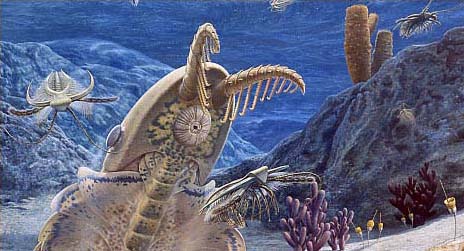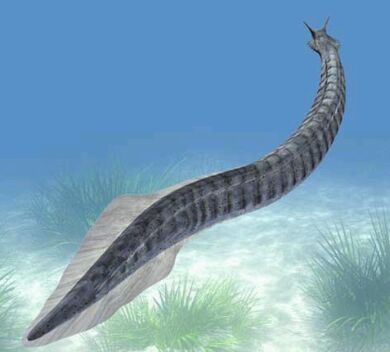 |
 |
 |
 |
 |
Produced
by the Population Genetics and Evolution class, Furman University |
||||
 |
 |
 |
 |
 |
Produced
by the Population Genetics and Evolution class, Furman University |
||||
 |
The
Cambrian: Pikaia |
 |
||
| One of the
oldest known chordates, Pikaia gracilens was an organism much
like a small eel or hagfish that swam above the ocean floor using its
expanded tailfin, seen at right, and its serpentine body (Smithsonian
Institution 2010). It was found in the Burgess Shale Formation, and along
with two other chordate taxa, Haikouichthys and Zhangjianichthys,
in the Lower Cambrian Chengjiang Lagerstätte of Yunnan, China (Morris
2008). It is considered to be related to the hagfish because of fleshy
apomorphies such as its tentacles, but lacks certain vertebral characteristics
that prevent it from being classified in that taxa and is instead considered
to be a tentative cephalochordate (Donoghue and Purnell 2005). Some have
argued that it should be placed with the Arthropoda, but P. gracilens
lacks key characteristics of that phylum. It lacks an exoskeleton and
jointed legs, and though its body appears segmented, the “segmentations”
are more likely to be muscle bundles imprinted on the surface of the skin.
It is these “segmentations,” which appear in a V-shaped pattern
in the fossil record, which led to the classification of P. gracilens
as a chordate; such a pattern is typical of chordate morphology (UCMP
2010). Page by Will Towler |
 |
| Pikaia gracilens. Picture from: The Cambrian Critter Project | |
|
Donoghue P, Purnell M. 2005. Genome duplication, extinction and chordate evolution. Trends in Ecology and Evolution 20 (20): 1-8.. Morris S. 2008. A Redescription of a rare Chordate, Metaspriggina walcotti Simonetta and Insom, from the Burgess Shale (Middle Cambrian), British Columbia, Canada. Journal of Paleontology 82:424-430. University of California Museum of Paleontology Understanding Evolution: Pikaia, a Chordate. Accessed February 1, 2010. Smithsonian Institution. 2010. Burgess Shale: Pikaia gracilens (a primitive chordate). Accessed February 1, 2010. |